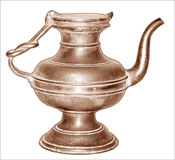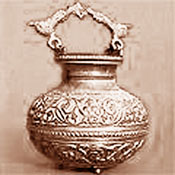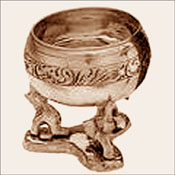|
observer |
|
|
|
|
|
OTHER LINKS |

|

|

|
Beautiful, glittering brasswareDo you have brass lamps or brass vases in your home? There are sure to be at least a few brassware items in your households. Today, we are going to tell you about their history and some facts about them.
According to archaeological sources, the use of metal products has been seen in 12th century Polonnaruwa too. Steel and copper surgical instruments including scissors, scalpels, pincers, and needles are some of the artifacts found at places such as the Mihintale hospital site. The Mahavamsa records that bronze and brass casting evolved in the Kandy period. In a later period, Sri Lankan metal-workers were believed to have been influenced by Indian metal-workers in their methods of brass-casting and mixed-metal work. Brass-carving developed further after the Second World War, with the demand for brass souvenirs and gifts from tourists visiting Sri Lanka. Brass trays, wall-plaques, and ornamental animals and bowls were also common souvenirs of the era.
A wide range of items involve brass-work; from locks, hinges, and key-plates, to trays, lanterns, arecanut slicers, lime-boxes in various shapes and patterns intricately carved in copper and silver, snuff-boxes, tobacco-boxes (heppu ) with engraved traditional designs, small artistically crafted betel-pounders, and mountings of all kinds including those used in jewellery products. Brass lamps made by metal-workers through various historical periods highlight the continuing technical expertise (skill) of a brass craftsperson. If you notice the bells and lamps used in Buddhist and Hindu temples as well as those of Christian churches, are also made of brass. The metal-casting and metal-designing requirements of many places of Buddhist worship were instrumental in the choice of location. Kandy, therefore, is very well known for cast or wrought brassware ornamented with fine carving, silver or copper inlays. Common items made of brass
The killotaya or lime-boxes were also mainly made of copper or brass, rarely of iron or steel. The designs on several varieties of brass boxes display European influence. Kandy is well known for the flat oval Dutch tobacco boxes or heppu made of brass; betel-boxes have the same form, but are engraved with pure designs. The handles of the small box-like heppu were generally made of brass, and occasionally of silver.Along with being crafted as earthenware, vessels were also cast in brass and bronze. Among ritualistic vessels, the most recognisable is perhaps the kotalaya or water vessel found in every vihara or place of worship. These open-spouted vessels are usually used for sprinkling water on flowers placed on the altar; sometimes they are also used to store drinking water. The tel kulava is a vessel with a narrow grooved spout that is used to hold coconut oil to pour for the lighted lamps, while the kendiya is a spouted vessel with a lid made of copper, brass or silver. In the Tamil majority northern parts of Sri Lanka, enormous brass vessels are used by the women to transport water. Indian metal artisans, who settled in the central and southern parts of Sri Lanka, make large brass lamps.You may also have seen such brassware in your house or in your grandparents' houses. Just check how they have been designed. In the next Heritage Splendour page, we'll tell you more about the designs in brassware, how they are done and where they are done. - Janani Amarasekara. |

 Iron-smelting (heating and melting to extract metal) and
steel-tempering (bringing metal to required consistency) have been
practiced in ancient times in some villages near Balangoda, along with
the districts in the South, and in Kandy, which is in the central region
of the country. Though the quantity was not very large, the quality had
been superb. You will be astonished to hear that we even exported steel
to Damascus, Syria to make swords in ancient times.
Iron-smelting (heating and melting to extract metal) and
steel-tempering (bringing metal to required consistency) have been
practiced in ancient times in some villages near Balangoda, along with
the districts in the South, and in Kandy, which is in the central region
of the country. Though the quantity was not very large, the quality had
been superb. You will be astonished to hear that we even exported steel
to Damascus, Syria to make swords in ancient times. 
 Metal-work in brass (a mix of copper and zinc) falls into two groups,
wrought (shaped by hammering) and cast (shaped with the use of moulds).
Casting is done usually by foundry workers, while hammering and chasing
(engraving) is done by metal artisans.
Metal-work in brass (a mix of copper and zinc) falls into two groups,
wrought (shaped by hammering) and cast (shaped with the use of moulds).
Casting is done usually by foundry workers, while hammering and chasing
(engraving) is done by metal artisans.  Arecanut slicers or gira are among the most common items made of
brass (with the exception of the cutting blade), and were often
elaborately ornamented, sometimes with inlay work done with silver
wires. Equally elaborate were betel pounders or bulat-vangedi and, small
iron mortars with brass-mounted pestles that had figures of Lord Ganesha
on them. These were made of plain iron and the shape was based on the
claw of the et-kanda-lihiniya, the great elephant devouring rock.
Arecanut slicers or gira are among the most common items made of
brass (with the exception of the cutting blade), and were often
elaborately ornamented, sometimes with inlay work done with silver
wires. Equally elaborate were betel pounders or bulat-vangedi and, small
iron mortars with brass-mounted pestles that had figures of Lord Ganesha
on them. These were made of plain iron and the shape was based on the
claw of the et-kanda-lihiniya, the great elephant devouring rock. 






